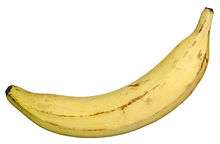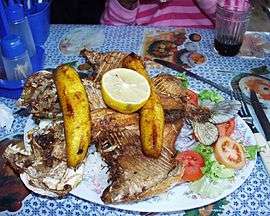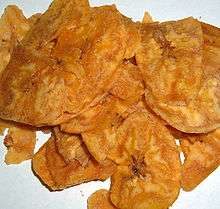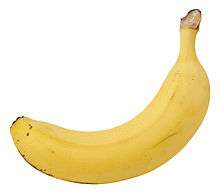Cooking banana
Cooking bananas[1][2][3] are banana cultivars in the genus Musa whose fruits are generally used in cooking. They may be eaten ripe or unripe and are generally starchy. Many cooking bananas are referred to as plantains (/ˈplæntɪn/[4][5] US: /plænˈteɪn/,[6] UK: /ˈplɑːntɪn/[4]) or green bananas, although not all of them are true plantains. Bananas are treated as a starchy fruit with a relatively neutral flavour and soft texture when cooked. Bananas fruit all year round, making them a reliable all-season staple food.
| Cooking bananas | |
|---|---|
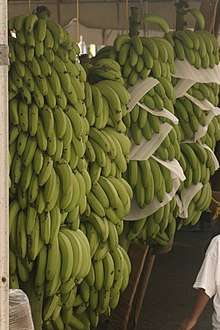 Large bunch of cooking bananas | |
| Genus | Musa |
| Species | Musa × paradisiaca |
| Hybrid parentage | M. acuminata × M. balbisiana |
| Cultivar group | Cultivars from a number of groups, including the AAA Group, the AAB Group and the ABB Group |
| Origin | primary: Southeast Asia; secondary: West Africa; tertiary: Central America |
_and_one_loose_plantain.jpg)
Cooking bananas are a major food staple in West and Central Africa, the Caribbean islands, Central America, and northern South America. Members of the genus Musa are indigenous to the tropical regions of Southeast Asia and Oceania, including the Malay Archipelago (modern Indonesia, Malaysia, Brunei and the Philippines) and Northern Australia.[7] Africa is considered a second centre of diversity for Musa cultivars: West Africa for some plantains and the central highlands for East African Highland bananas (Musa AAA-EAHB; known as matoke in Uganda), most of which are cooked, although some are primarily used to make beer.
The term "plantain" is loosely applied to any banana cultivar that is usually cooked before it is eaten. However, there is no botanical distinction between bananas and plantains. Cooking is also a matter of custom, rather than necessity, for many bananas. Ripe plantains can be eaten raw, since their starches are converted to sugars in the ripening process. In countries where only a few cultivars of banana are consumed, there may be a clear distinction between plantains and bananas; in countries where many cultivars are consumed, there is no distinction in the common names used.[8]
In botanical usage, the term "plantain" is used only for true plantains, while other starchy cultivars used for cooking are called "cooking bananas".[9][10][11] All modern true plantains have three sets of chromosomes (i.e. they are triploid). Many are hybrids derived from the cross of two wild species, Musa acuminata and Musa balbisiana. The currently accepted scientific name for all such crosses is Musa × paradisiaca.[12] Using Simmonds and Shepherds' 1955 genome-based nomenclature system,[13] cultivars which are cooked often belong to the AAB Group, although some (e.g. the East African Highland bananas) belong to the AAA Group, and others (e.g. Saba bananas) belong to the ABB Group.
Fe'i bananas (Musa × troglodytarum) from the Pacific Islands are often eaten roasted or boiled, and are thus informally referred to as "mountain plantains." However, they do not belong to either of the two species from which all modern banana cultivars are descended.[14][15]
Description
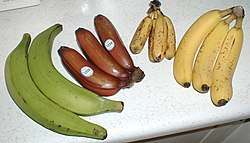
Plantains contain more starch and less sugar than dessert bananas, therefore they are usually cooked or otherwise processed before being eaten. They are always cooked or fried when eaten green. At this stage, the pulp is hard and the peel often so stiff that it has to be cut with a knife to be removed.
Mature, yellow plantains can be peeled like typical dessert bananas; the pulp is softer than in immature, green fruit and some of the starch has been converted to sugar. They can be eaten raw, but are not as flavourful as dessert bananas, so are usually cooked. When yellow plantains are fried, they tend to caramelize, turning a golden-brown color. They can also be boiled, baked, microwaved, or grilled over charcoal, either peeled or unpeeled.
Plantains are a staple food in the tropical regions of the world, ranking as the tenth most important staple food in the world. As a staple, plantains are treated in much the same way as potatoes and with a similar neutral flavour and texture when the unripe fruit is cooked by steaming, boiling, or frying.
Since they fruit all year round, plantains are a reliable, all-season staple food, particularly in developing countries with inadequate food storage, preservation, and transportation technologies. In Africa, plantains and bananas provide more than 25 percent of the caloric requirements for over 70 million people.[16] Plantain plantations are vulnerable to destruction by hurricanes, because Musa spp. do not withstand high winds well.
An average plantain provides about 920 kilojoules (220 kilocalories) of food energy and is a good source of potassium and dietary fiber.[17] The sap from the fruit peel, as well as the entire plant, can stain clothing and hands, and can be difficult to remove.[18]
Taxonomy
Linnaeus originally classified bananas into two species based only on their uses as food: Musa paradisiaca for plantains and Musa sapientum for dessert bananas. Both are now known to be hybrids between the species Musa acuminata (A genome) and Musa balbisiana (B genome). The earlier published name, Musa × paradisiaca, is now used as the scientific name for all such hybrids. Most modern plantains are sterile triploids belonging to the AAB Group, sometimes known as the "Plantain group". Other economically important cooking banana groups include the East African Highland bananas (Mutika/Lujugira subgroup) of the AAA Group and the Pacific plantains (including the Popoulo, Maoli, and Iholena subgroups), also of the AAB Group.[19]
Dishes
Africa
Plantains are used in the Ivory Coast dish aloco as the main ingredient. Fried plantains are covered in an onion-tomato sauce, often with a grilled fish between the plantains and sauce.[20]
Boli is the term used for roasted plantain in Nigeria. The plantain is usually grilled and served with roasted fish, ground peanuts and a hot palm oil sauce. It is very popular as a lunch snack in southern and western Nigeria, for example in Rivers State, Bayelsa State, Cross River State, Delta State, Edo State and Lagos State. It is popular among the working class as a quick midday meal.
Plantain is popular in West Africa, especially Cameroon, Bénin, Ghana and Nigeria; when ripe plantain is fried, it is generally called dodo (dough – dough). The ripe plantain is usually sliced diagonally for a large oval shape, then fried in oil to a golden brown color. This can be eaten as such, with stew or served with beans or on rice.
In Ikire, a town in Western Nigeria precisely Osun State, there is a special and unique way of preparing plantain chips. This is popularly called Dodo Ikire. Dodo Ikire is made from overripe plantain, chopped in small pieces, sprinkled with chili pepper and fried in boiling point palm oil. After frying it turns blackish. The fried plantain chips are then stuffed carefully into a special conically shaped woven basket about 10 centimetres (4 inches) high. This special dodo can have a preservative quality that lasts up to two months without refrigeration.
Matooke, or matoke, is a cooking banana dish of the Baganda, now widely prepared in Uganda, Tanzania, Rwanda and eastern Congo. The cooking bananas (specifically East African Highland bananas) are peeled, wrapped in the plant's leaves and set in a cooking pot (a sufuria) on the stalks that have been removed from the leaves. The pot is then placed on a charcoal fire and the matoke is steamed for a few hours. While uncooked, the matoke is white and fairly hard, but cooking turns it soft and yellow. The matoke is then mashed while still wrapped in the leaves, and often is served on a fresh leaf and eaten with a sauce made of vegetables, ground peanuts, or some type of meat (goat meat and beef are common).
Caribbean
Fufu de platano is a traditional and very popular lunch dish in Cuba, and essentially akin to the Puerto Rican mofongo. It is a fufu made by boiling the plantains in water and mashing with a fork. The fufu is then mixed with chicken stock and sofrito, a sauce made from lard, garlic, onions, pepper, tomato sauce, a touch of vinegar and cumin. The texture of Cuban fufu is similar to the mofongo consumed in Puerto Rico, but it is not formed into a ball or fried. Fufu is also a common centuries-old traditional dish made in Côte d'Ivoire, Ghana, Nigeria, Cameroon and other West & Central African countries. It is made in a similar fashion as the Cuban fufu, but is pounded, and has a thick paste, putty-like texture which is then formed into a ball. West African fufu is sometimes separately made with cassava, yams or made with plantains combined with cassava.
Eto is a popular Ghanaian traditional dish. It is mainly made from boiled and mashed yam or plantain. For the plantain option called 'Boodie eto', the plantain can be used unripe, slightly ripe or fully ripe.
Culturally, it was the food fed to a bride on the day of her marriage and it's best savored with a whole egg, groundnut (peanuts) and sliced avocado.
A traditional mangú from the Dominican Republic consists of peeled green, boiled plantains, mashed with enough hot water they were boiled in so the consistency is a little stiffer than mashed potatoes. It is traditionally eaten for breakfast, topped with sautéed red onions in apple cider vinegar and accompanied by fried eggs, fried cheese, and/or fried bologna sausage thats known as Dominican salami.
Central and South America
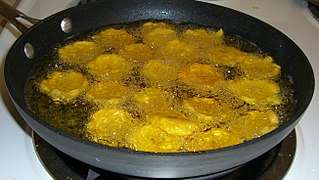
Cayeye, also called Mote de Guineo, is a traditional Colombian dish from the Caribbean Coast of the country. Cayeye is made by cooking small green bananas or plantains in water, then mashing and mixing them with refrito, made with onions, garlic, red bell pepper, tomato and achiote.
Cayeye are usually served for breakfast with fresh grated Colombian cheese (Queso Costeño) and fried fish, shrimp, crab, or beef. Most popular is Cayeye with fresh cheese, avocado and fried egg on top.
Chifles is the Spanish term used in Peru and Ecuador for fried green plantains sliced (1 or 2 mm thick); it is also used to describe plantain chips which are sliced thinner. In Ecuador, plantain is boiled, crushed, scrambled, and fried into majado. This dish is typically served with a cup of coffee and bistek, fish, or grated cheese. It is a popular breakfast dish. Majado is also used as a base to prepare tigrillo and bolones. To prepare trigrillo, majado is scrambled with pork rind, egg, cheese, green onions, parsley, and cilantro. To prepare bolones, majado is scrambled with cheese, pork rind, or a mixture of both. The resulting mixture is then shaped into a sphere which is later deep-fried. Both tigrillo and bolones are typically served with a cup of coffee.
In Honduras, Venezuela and Central Colombia, fried ripened plantain slices are known as tajadas. They are customary in most typical meals, such as the Venezuelan pabellón criollo. The host or waiter may also offer them as barandas (guard rails), in common slang, as the long slices are typically placed on the sides of a full dish, and therefore look as such. Some variations include adding honey or sugar and frying the slices in butter, to obtain a golden caramel; the result has a sweeter taste and a characteristic pleasant smell. The same slices are known as amarillos and fritos maduros in Puerto Rico and the Dominican Republic respectively.
In Honduras, they are a popular takeaway food, usually with fried chicken, though they are also regularly eaten at home. They are popular chips sold in pulperias (minimarkets). In Panama, tajadas are eaten daily together with steamed rice, meat and beans, thus making up an essential part of the Panamanian diet, as with Honduras.
By contrast, in Nicaragua, tajadas are fried unripened plantain slices, and are traditionally served in a fritanga or with fried pork, or on their own on green banana leaves, either with a cabbage salad or fresh cheese.
On Colombia's Caribbean coast, tajadas of fried green plantain are consumed along with grilled meats, and are the dietary equivalent of the French-fried potatoes/chips of Europe and North America.
After removing the skin, the ripened fruit (maduro) can be sliced (between 3 mm and 2 cm thick) and pan-fried in oil until golden brown or according to preference. In the Dominican Republic, Ecuador, Colombia, Honduras (where they are usually eaten with the native sour cream) and Venezuela, they are also eaten baked in the oven (sometimes with cinnamon). In Puerto Rico baked plátanos maduros are usually eaten for breakfast and served with eggs (mainly an omelet with cheese), chorizo or bacon. Only salt is added to green plantains.
Tostones (also known as banann peze in Haiti, tachinos or chatinos in Cuba, platanos verdes fritos or fritos verdes in the Dominican Republic and patacones in Colombia, Costa Rica, Ecuador, Honduras, Panama, Peru and Venezuela) are twice-fried plantain patties, often served as a side dish, appetizer, or snack. Plantains are sliced in 4-centimetre-long (1 1⁄2-inch) pieces and fried in oil. The segments are then removed and individually smashed down either with the bottom of a bottle or with a tostonera, to about half their original height. Finally, the pieces are fried again and then seasoned, often with salt. In some countries, such as Haiti, Cuba, Puerto Rico and the Dominican Republic, the tostones are dipped in creole sauce from chicken, pork, beef, or shrimp before eating. In Nicaragua, tostones are typically served with fried cheese (Tostones con queso) and sometimes with refried beans. In some South American countries, the name tostones is used to describe this food when prepared at home and also plantain chips (mentioned above), which are typically purchased from a store.
In western Venezuela, much of Colombia and the Peruvian Amazon, patacones are a frequently seen variation of tostones. Plantains are sliced in long pieces and fried in oil, then used to make sandwiches with pork, beef, chicken, vegetables and ketchup. They can be made with unripe patacon verde or ripe patacon amarillo plantains. Tostones in the Dominican Republic are only fried once and are thicker than chips. Although there are local names for tostones in almost every Latin country, they are still commonly called tostones in all of Latin America.
Tacacho is a roasted plantain Amazonian cuisine dish from Peru. It is usually served con cecina, with bits of pork.
In Venezuela, a yo-yo is a traditional dish made of two short slices of fried ripened plantain (see Tajadas) placed on top of each other, with local soft white cheese in the middle (in a sandwich-like fashion) and held together with toothpicks. The arrangement is dipped in beaten eggs and fried again until the cheese melts and the yo-yo acquires a deep golden hue. They are served as sides or entrees.
India
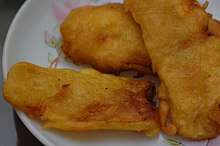
Ethakka appam, pazham (banana) boli or pazham pori are terms used for fried plantain in Kerala. The plantain is usually dipped in sweetened rice and white flour batter and then fried in coconut or vegetable oil. It is a very popular snack among Keralites. This is very similar to pisang goreng (Indonesian for fried bananas), which is a dessert common to Malaysia, Indonesia and Singapore. It is also known as Bajji in Tamil Nadu.
An alternative way of cooking in Kerala is to boil or steam the banana, which is also at times filled with grated coconut, cardamon powder and sugar/jaggery and then sauteed in ghee.
Indonesia
Nagasari is a traditional steamed kue (Indonesian traditional cake) made from rice flour, coconut milk and sugar, filled with slices of banana.[21][22] It is usually wrapped in banana leaves before being steamed, or prepared with pandan that gives it aroma.[23] It is commonly eaten as a snack in Indonesia[24] where it is also known as kue bandang-bandang by Bugis people. Sometimes it is simply called kue pisang (banana cake).
Pisang goreng ("fried banana" in Indonesian and Malay) is a plantain snack deep-fried in coconut oil. Pisang goreng can be coated in batter flour or fried without batter. It is a snack food mostly found in Indonesia, Malaysia, Singapore and Brunei.[25]
Philippines
.jpg)
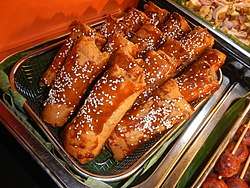
The most important Philippine cooking banana is the saba (or Cardaba) banana. These are much smaller than the Latin American varieties, usually around 4–5 inches, and somewhat boxy in shape. Although not a staple, saba bananas are commonly cooked in a wide variety of native dishes.[26]
They are cooked and eaten mostly in their ripe stage in dessert dishes, including:
- Banana cue - fried ripe saba bananas coated with caramelized sugar.[27]
- Binignit - a dessert soup of glutinous rice in coconut milk with ripe saba bananas as one of the main ingredients.[28]
- Ginanggang - grilled saba bananas coated with margarine and sugar.[29]
- Minatamis na saging - saba bananas simmered in a sweet syrup. It is rarely eaten alone, but is instead used as an ingredient in other desserts, notably halo halo.[31][32][33]
- Nilupak na saging - mashed saba bananas mixed with sweetened coconut milk.[34]
- Pritong saging - fried ripe saba bananas.[35]
- Pinasugbo - thinly sliced bananas coated with caramelized sugar and sesame seeds and fried until crunchy.[36][37]
- Saba con hielo - a shaved ice dessert which primarily uses minatamis na saging and milk.
- Turon - a type of dessert lumpia (spring rolls) made from ripe saba bananas wrapped in thin crepe and fried.[38]
Savory dishes that use saba bananas include:
- Arroz a la Cubana - a Spanish rice dish (which may have originated ultimately from the Philippines, despite the name). The Philippine version is served with a side of fried bananas.[39][40]
Puerto Rico
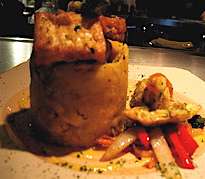
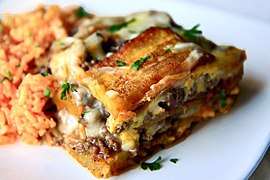
Puerto Rico has a close relationship with plantains. Many dishes originating from Puerto Rico can be seen in other parts the Caribbean and Latin America.
- Alcapurria is a type of savory fritter. Although usually consisting mainly of grated green bananas and yautias, they can also contain plantains. The masa (dough) is used to encase a filling of ground meat (picadillo), and the alcapurrias are then deep-fried.
- Arañitas (Little spiders in Spanish translation), a patty fritter made from shredded unripe and ripe plantains sometimes mixed with herbs, cheese, spices, eggs, cetí (small fish found in Arecibo) and crabmeat.
- Bolitas de platano is a green plantain dumplings. The plantains are grated and mixed with flour, seasoning, garlic, parsley, and annatto oil. They are then formed into a ball about the size of a golf ball. The balls are first deep fried and then dropped into a hot broth or soup. It is common to grate squash, potato, and green banana into the mix.
- Breakfast - roasted sweet plantains with butter, sugar and cinnamon is a typical breakfast in Puerto Rico with coffee or hot chocolate. Pancakes made with eggs, cassava flour, flour, coconut milk and mashed sweet plantains with other ingredients is popular in the south of the island.
- Desserts - made with sweet plantains are used often. Crème caramel, flan, crème brûlée, ice cream (Lares Ice Cream Parlor), platano en almibar (caramelized in butter, spices, rum and wine), cazuela (pie made with coconut, plantains, raisins, and other ingredients), bread pudding, buñuelo (plantain doughnuts), churro, and other dessters.
- Guanimes are a type of sweet and savory dumpling that can be made with a corn flour mixed with mashed ripe and unripe plantain. This recipe uses plantains along with coconut milk for the dumplings, which are wrapped in plantain leaves and boiled in chicken broth. A sweeter version contains corn flour, raisins, ripe plantains, coconut flakes, coconut milk and sugar.
- Mofongo originating from Puerto Rico, and essentially akin to the Cuban fufu, mofongo is made by mashing fried plantains in a mortar with chicharrón or bacon, garlic, olive oil and stock. Any meat, fish, shellfish, vegetables, spices, or herbs can also be added. The resulting mixture is formed into cylinders the size of about two fists and eaten warm, usually with chicken broth.
- Mofongo relleno is topped with creole sauce rather than served with chicken broth. Creole sauce may contain stewed beef, chicken or seafood; it is poured into a center crater, formed with the serving spoon, in the mofongo.
- Pasta sweet plantains are mixed with flour, eggs, and/or water to make noodles, ravioli dough, gnocchi, and lasagne (flat wide pasta) in upscale restaurants on the island.
- Pasteles are a type of dumpling made from green banana, green plantains, squash and other tubers stuffed with stew pork and wrapped in banana leaf. They are usually served on Christmas.
- Piñon is similar to lasagna, but uses sweet plantains (amarillitos) to replace the pasta layers. A similar dish called pastelon is made with layers of mashed plantains.
- Piononos a popular Caribbean dish named after Pope Pius IX. Sweet plantain forming a ring stuffed with seasoned meat or seafood, with an egg-and-flour mixture covering both open sides of the ring and deep-fried.
- Ralleno de amarillitos are sweet plantain fritters. Sweet plantains are mashed with flour, stuffed with meat or cheese or both. They are then shaped into balls rolled in egg whites, and cornmeal or breadcrumbs.
Other preparations
Chips
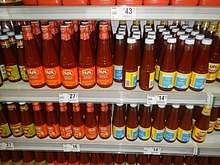
After removing the skin, the unripe fruit can be sliced thin and deep fried in hot oil to produce chips. This thin preparation of plantain is known as tostones, patacones or plataninas in some of Central American and South American countries, platanutres in Puerto Rico, mariquitas or chicharritas in Cuba and chifles in Ecuador and Peru. In Cuba, the Dominican Republic, Guatemala, Puerto Rico and Venezuela, tostones instead refers to thicker twice-fried patties (see below). In Cuba, plantain chips are called mariquitas. They are sliced thinly, and fried in oil until golden colored. They are popular appetizers served with a main dish. In Colombia they are known as platanitos and are eaten with suero atollabuey as a snack. Tostada refers to a green, unripe plantain which has been cut into sections, fried, flattened, fried again, and salted. These tostadas are often served as a side dish or a snack. They are also known as tostones or patacones in many Latin American countries. In Honduras, banana chips are called tajadas, which may be sliced vertically to create a variation known as plantain strips.
Chips fried in coconut oil and sprinkled with salt, called upperi or kaya varuthathu, are a snack in South India in Kerala.[43] They are an important item in sadya, a vegetarian feast prepared during festive occasions in Kerala. The chips are typically labeled "plantain chips" when they are made of green plantains that taste starchy, like potato chips. In Tamil Nadu, a thin variety made from green plantains is used to make chips seasoned with salt, chili powder and asafoetida. In the western/central Indian language Marathi, the plantain is called rajeli kela (figuratively meaning "king-sized" banana), and is often used to make fried chips.
Dried flour
Plantains are also dried and ground into flour; "banana meal" forms an important foodstuff.
In southern India, dried plantain powder is mixed with a little bit of fennel seed powder and boiled in milk or water to make baby food to feed babies until they are one year old.
Drink
In Peru, plantains are boiled and blended with water, spices, and sugar to make chapo. In Kerala , ripe plantains are boiled with sago, coconut milk, sugar and spices to make a pudding.
Ketchup
The Philippines uniquely processes saba bananas into banana ketchup. It was originally invented in World War 2 as a substitute for tomato ketchup.[44][45]
Nutrition
| Nutritional value per 100 g (3.5 oz) | |
|---|---|
| Energy | 510 kJ (120 kcal) |
31.89 g | |
| Sugars | 10 g |
| Dietary fiber | 2.3 g |
0.37 g | |
1.3 g | |
| Vitamins | Quantity %DV† |
| Vitamin A equiv. | 7% 56 μg4% 457 μg |
| Thiamine (B1) | 5% 0.052 mg |
| Riboflavin (B2) | 5% 0.054 mg |
| Niacin (B3) | 5% 0.686 mg |
| Pantothenic acid (B5) | 5% 0.26 mg |
| Vitamin B6 | 23% 0.299 mg |
| Folate (B9) | 6% 22 μg |
| Choline | 3% 13.5 mg |
| Vitamin C | 22% 18.4 mg |
| Vitamin E | 1% 0.14 mg |
| Vitamin K | 1% 0.7 μg |
| Minerals | Quantity %DV† |
| Calcium | 0% 3 mg |
| Iron | 5% 0.6 mg |
| Magnesium | 10% 37 mg |
| Phosphorus | 5% 34 mg |
| Potassium | 11% 499 mg |
| Sodium | 0% 4 mg |
| Zinc | 1% 0.14 mg |
| Other constituents | Quantity |
| Water | 65.3 g |
| |
| †Percentages are roughly approximated using US recommendations for adults. Source: USDA Nutrient Database | |
Plantain is 32% carbohydrates with 2% dietary fiber and 15% sugars, 1% protein, 0.4% fat, and 65% water, and supplying 510 kilojoules (122 kilocalories) of food energy in a 100-gram (3 1⁄2-ounce) reference serving (table). Raw plantain is an excellent source (20% or higher of the Daily Value, DV) of vitamin B6 (23% DV) and vitamin C (22% DV), and a good source (10–19% DV) of magnesium and potassium (table).
Containing little beta-carotene (457 micrograms per 100 grams), plantain is not a good source of vitamin A (table).
Comparison to other staple foods
The following table shows the nutrient content of raw plantain and major staple foods.
| Nutrient | Maize (corn)[A] | Rice, white[B] | Wheat[C] | Potatoes[D] | Cassava[E] | Soybeans, green[F] | Sweet potatoes[G] | Yams[Y] | Sorghum[H] | Plantain[Z] | RDA |
|---|---|---|---|---|---|---|---|---|---|---|---|
| Water (g) | 10 | 12 | 13 | 79 | 60 | 68 | 77 | 70 | 9 | 65 | 3,000 |
| Energy (kJ) | 1,528 | 1,528 | 1,369 | 322 | 670 | 615 | 360 | 494 | 1,419 | 511 | 8,368–10,460 |
| Protein (g) | 9.4 | 7.1 | 12.6 | 2.0 | 1.4 | 13.0 | 1.6 | 1.5 | 11.3 | 1.3 | 50 |
| Fat (g) | 4.74 | 0.66 | 1.54 | 0.09 | 0.28 | 6.8 | 0.05 | 0.17 | 3.3 | 0.37 | 44–77 |
| Carbohydrates (g) | 74 | 80 | 71 | 17 | 38 | 11 | 20 | 28 | 75 | 32 | 130 |
| Fiber (g) | 7.3 | 1.3 | 12.2 | 2.2 | 1.8 | 4.2 | 3 | 4.1 | 6.3 | 2.3 | 30 |
| Sugar (g) | 0.64 | 0.12 | 0.41 | 0.78 | 1.7 | 0 | 4.18 | 0.5 | 0 | 15 | minimal |
| Minerals | [A] | [B] | [C] | [D] | [E] | [F] | [G] | [Y] | [H] | [Z] | RDA |
| Calcium (mg) | 7 | 28 | 29 | 12 | 16 | 197 | 30 | 17 | 28 | 3 | 1,000 |
| Iron (mg) | 2.71 | 0.8 | 3.19 | 0.78 | 0.27 | 3.55 | 0.61 | 0.54 | 4.4 | 0.6 | 8 |
| Magnesium (mg) | 127 | 25 | 126 | 23 | 21 | 65 | 25 | 21 | 0 | 37 | 400 |
| Phosphorus (mg) | 210 | 115 | 288 | 57 | 27 | 194 | 47 | 55 | 287 | 34 | 700 |
| Potassium (mg) | 287 | 115 | 363 | 421 | 271 | 620 | 337 | 816 | 350 | 499 | 4,700 |
| Sodium (mg) | 35 | 5 | 2 | 6 | 14 | 15 | 55 | 9 | 6 | 4 | 1,500 |
| Zinc (mg) | 2.21 | 1.09 | 2.65 | 0.29 | 0.34 | 0.99 | 0.3 | 0.24 | 0 | 0.14 | 11 |
| Copper (mg) | 0.31 | 0.22 | 0.43 | 0.11 | 0.10 | 0.13 | 0.15 | 0.18 | - | 0.08 | 0.9 |
| Manganese (mg) | 0.49 | 1.09 | 3.99 | 0.15 | 0.38 | 0.55 | 0.26 | 0.40 | - | - | 2.3 |
| Selenium (μg) | 15.5 | 15.1 | 70.7 | 0.3 | 0.7 | 1.5 | 0.6 | 0.7 | 0 | 1.5 | 55 |
| Vitamins | [A] | [B] | [C] | [D] | [E] | [F] | [G] | [Y] | [H] | [Z] | RDA |
| Vitamin C (mg) | 0 | 0 | 0 | 19.7 | 20.6 | 29 | 2.4 | 17.1 | 0 | 18.4 | 90 |
| Thiamin (B1) (mg) | 0.39 | 0.07 | 0.30 | 0.08 | 0.09 | 0.44 | 0.08 | 0.11 | 0.24 | 0.05 | 1.2 |
| Riboflavin (B2) (mg) | 0.20 | 0.05 | 0.12 | 0.03 | 0.05 | 0.18 | 0.06 | 0.03 | 0.14 | 0.05 | 1.3 |
| Niacin (B3) (mg) | 3.63 | 1.6 | 5.46 | 1.05 | 0.85 | 1.65 | 0.56 | 0.55 | 2.93 | 0.69 | 16 |
| Pantothenic acid (B5) (mg) | 0.42 | 1.01 | 0.95 | 0.30 | 0.11 | 0.15 | 0.80 | 0.31 | - | 0.26 | 5 |
| Vitamin B6 (mg) | 0.62 | 0.16 | 0.3 | 0.30 | 0.09 | 0.07 | 0.21 | 0.29 | - | 0.30 | 1.3 |
| Folate Total (B9) (μg) | 19 | 8 | 38 | 16 | 27 | 165 | 11 | 23 | 0 | 22 | 400 |
| Vitamin A (IU) | 214 | 0 | 9 | 2 | 13 | 180 | 14,187 | 138 | 0 | 1,127 | 5,000 |
| Vitamin E, alpha-tocopherol (mg) | 0.49 | 0.11 | 1.01 | 0.01 | 0.19 | 0 | 0.26 | 0.39 | 0 | 0.14 | 15 |
| Vitamin K1 (μg) | 0.3 | 0.1 | 1.9 | 1.9 | 1.9 | 0 | 1.8 | 2.6 | 0 | 0.7 | 120 |
| Beta-carotene (μg) | 97 | 0 | 5 | 1 | 8 | 0 | 8,509 | 83 | 0 | 457 | 10,500 |
| Lutein+zeaxanthin (μg) | 1,355 | 0 | 220 | 8 | 0 | 0 | 0 | 0 | 0 | 30 | 6,000 |
| Fats | [A] | [B] | [C] | [D] | [E] | [F] | [G] | [Y] | [H] | [Z] | RDA |
| Saturated fatty acids (g) | 0.67 | 0.18 | 0.26 | 0.03 | 0.07 | 0.79 | 0.02 | 0.04 | 0.46 | 0.14 | minimal |
| Monounsaturated fatty acids (g) | 1.25 | 0.21 | 0.2 | 0.00 | 0.08 | 1.28 | 0.00 | 0.01 | 0.99 | 0.03 | 22–55 |
| Polyunsaturated fatty acids (g) | 2.16 | 0.18 | 0.63 | 0.04 | 0.05 | 3.20 | 0.01 | 0.08 | 1.37 | 0.07 | 13–19 |
| [A] | [B] | [C] | [D] | [E] | [F] | [G] | [Y] | [H] | [Z] | RDA |
Allergies
Plantain and banana allergies occur with typical characteristics of food allergy or latex fruit syndrome,[47][48] including itching and mild swelling of the lips, tongue, palate or throat, skin rash, stomach complaints or anaphylactic shock. Among more than 1000 proteins identified in Musa species were numerous previously described protein allergens.[49]
See also
- List of banana cultivars
- List of banana dishes
- Cavendish banana subgroup
- Gros Michel banana
- Matoke
- Musa balbisiana
- Rhino Horn banana
- Saba banana
References
- Luis A. Bello-Perez; Edith Agama-Acevedo; Olivier Gilbert; Domonique Dufour (2012). "Banana". In Muhammad Siddiq (ed.). Tropical and Subtropical Fruits: Postharvest Physiology, Processing and Packaging. Wiley-Blackwell. p. 149. ISBN 9781118324110.
- Alan Davidson (2014). Tom Jaine (ed.). The Oxford Companion to Food. Oxford Companions Series (3rd ed.). Oxford University Press. p. 58. ISBN 9780199677337.
- Jennifer Thomson (2014). "Africa". In Stuart J. Smyth; Peter W.B. Phillips; David Castle (eds.). Handbook on Agriculture, Biotechnology and Development. Edward Elgar Publishing. p. 107. ISBN 9780857938350.
- Wells, John (2000). Longman Pronunciation Dictionary. Harlow [England] : Pearson Education. ISBN 978-0-582-36467-7.
- "Merriam-Webster Dictionary".
-
- "Plantain". Oxford Dictionaries Online. Oxford University Press. April 2010. Retrieved 17 September 2010.
- "Plantains: John Well's phonetic blog". 17 September 2010.
- "Musa species (banana and plantain)" (PDF). Archived from the original (PDF) on 28 February 2014. Retrieved 12 April 2007.
- J. Redhead (1989). M. Boelen (ed.). Utilization of Tropical Foods: Trees. FAO Food and Nutrition Paper. Food and Agriculture Organization of the United Nations. p. 32. ISBN 9789251027769.
- S.S. Cronauer; A.D. Krikorian (2012). "Banana (Musa spp.)". In Y.P.S. Bajaj (ed.). Trees I. Biotechnology in Agriculture and Forestry. Springer Science & Business Media. p. 233. ISBN 9783642705762.
- R.V. Valmayor; S.H. Jamaluddin; B. Silayoi; S. Kusumo; L.D. Danh; O.C. Pascua; R.R.C. Espino (2000). "Banana Cultivar Names and Synonyms in Southeast Asia". In A.B. Molina; V.N. Roa (eds.). Advancing Banana and Plantain R&D in Asia and the Pacific. Bioversity International. p. 55. ISBN 9789719175131.
- Thi-Thanh-Tam Vu (2005). Modes of Action of Non-pathogenic Fusarium oxysporum Endophytes for Bio-enhancement of Banana Toward Radopholus similis. Cuvillier Verlag. p. 1. ISBN 9783865374752.
- "TAXON", World Checklist of Selected Plant Families, Royal Botanic Gardens, Kew, retrieved 4 April 2013
- "Musa paradisiaca". Archived from the original on 5 September 2008. Retrieved 29 August 2015.
- Mary Taylor (2003). "Status of Banana R&D in the Pacific". In A.B. Molina; V.N. Roa; I. Van der Bergh; M.A.G. Maghuyop; K. Borromeo (eds.). Advancing banana and plantain R & D in Asia and the Pacific Vol. 12: Proceedings of the 2nd BAPNET Steering Committee Meeting held in Jakarta, Indonesia, 6–11 October 2003. Bioversity International. p. 129.
- Paul Turnbull (5 May 2004). "Plantains". South Seas Companion. Retrieved 18 November 2016.
- UNCST (July 2007). "THE BIOLOGY OF BANANAS AND PLANTAINS" (PDF). Uganda National Council for Science and Technology in collaboration with PBS – a US Agency for International Development (USAID). Archived from the original (PDF) on 16 December 2011.
- "Plantains". Archived from the original on 15 January 2013. Retrieved 25 August 2009.
- "La mancha de plátano". El Nuevo Dia (in Spanish). 15 April 2011. Retrieved 30 July 2019.
- Randy C. Ploetz; Angela Kay Kepler; Jeff Daniells; Scot C. Nelson (2007). "Banana and plantain – an overview with emphasis on the Pacific island cultivars" (PDF). Species Profiles for Pacific Island Agroforestry. Retrieved 5 June 2011.
- "Aloco recipe". Aloco. congocookbook.com. Archived from the original on 18 July 2006. Retrieved 12 August 2006.
- Sitanala, J. E; Sitanggang, Hilderia; (Indonesia), Proyek Inventarisasi dan Dokumentasi Kebudayaan Daerah (1983). Isi dan kelengkapan rumah tangga tradisional menurut tujuan, fungsi dan ... – J. E. Sitanala, Hilderia Sitanggang, Proyek Inventarisasi dan Dokumentasi Kebudayaan Daerah (Indonesia) – Google Books. Retrieved 29 August 2015.
- Sidek, Noraini (2004). Sajian keraian, perancangan, penyediaan & resipi. ISBN 9789676115072. Retrieved 29 August 2015.
- "resepi kuih". Retrieved 29 August 2015.
- "Kue Nagasari". Kue Nusantara. 3 December 2010. Retrieved 6 June 2012.
- Tay, Leslie. "Million Stars Goreng Pisang". ieatishootipost.sg.
- Hautea, D.M., G.C. Molina, C.H. Balatero, N.B. Coronado, E.B. Perez, M.T.H. Alvarez, A.O. Canama, R.H. Akuba, R.B. Quilloy, R.B. Frankie, C.S. Caspillo (19 July 2002). "Analysis of induced mutants of Philippine bananas with molecular markers". Institute of Plant Breeding, College of Agriculture, University of the Philippines Los Baños, FAO Corporate Document Repository. Retrieved 12 January 2011.CS1 maint: multiple names: authors list (link)
- "Bananacue Recipe". Panlasang Pinoy. Retrieved 5 February 2020.
- "Binignit". Kawaling Pinoy. Retrieved 7 December 2018.
- "Filipino Street Foods". Lutong Pinoy Recipe. Retrieved 27 December 2010.
- Marketman (20 August 2005). "Maruya a la Marketman". Market Manila. Retrieved 18 December 2014.
- "Minatamis na Saging (Sweetened Saba Bananas)". Astig Vegan. Retrieved 20 March 2019.
- "Minatamis na Saging". Panlasang Pinoy. Retrieved 20 March 2019.
- "Minatamis na Saging Recipe (Caramelized Plantains Dessert)". Mama's Guide Recipes. Retrieved 23 April 2019.
- "Nilupak na Saging". Casa Baluarte. Retrieved 5 February 2020.
- "Fired Bananas (Pritong Saba)". Filipino Chow. Retrieved 5 February 2020.
- Piccio, Belle. "Pinasugbo: Visayas' All-Time-Favorite Pasalubong". ChoosePhilippines. Retrieved 8 July 2019.
- "Consilva or Pinasugbo a la Marketman". Market Manila. Retrieved 8 July 2019.
- Home Cooking Rocks website accessed on 16 November 2010
- Antonio Quilis, Celia Casado Fresnillo, (2008), La lengua española en Filipinas: Historia. Situación actual, CSIC, Madrid. (in Spanish)
- "Arroz ala Cubana". Ang Sarap. Retrieved 5 February 2020.
- "Nilagang Saging na Saba at Bagoong". Overseas Pinoy Cooking. Retrieved 5 February 2020.
- "Pochero Recipe". Yummy.ph. Retrieved 5 February 2020.
- Pereira, Ignatius (13 April 2013). "The taste of Kerala". The Hindu. Chennai, India. Retrieved 3 January 2014.
- "Food from The Philippines: Banana Ketchup". The Longest Way Home. Retrieved 16 May 2012.
- Jose, Ricardo (1998). KASAYSAYAN The Story of The Filipino People. Philippines: Asia Publishing Company Limited. ISBN 962-258-230-3.
- "Nutrient data laboratory". United States Department of Agriculture. Retrieved 10 August 2016.
- Brehler, R.; Theissen, U.; Mohr, C.; Luger, T. (1997). "'Latex-fruit syndrome': frequency of cross-reacting IgE antibodies". Allergy. 52 (4): 404–10. doi:10.1111/j.1398-9995.1997.tb01019.x. PMID 9188921.
- Wagner S, Breiteneder H (2002). "The latex-fruit syndrome". Biochem Soc Trans. 30 (6): 935–40. doi:10.1042/bst0300935. PMID 12440950. S2CID 9053520.CS1 maint: uses authors parameter (link)
- Esteve C, D'Amato A, Marina ML, García MC, Righetti PG (2013). "In-depth proteomic analysis of banana (Musa spp.) fruit with combinatorial peptide ligand libraries". Electrophoresis. 34 (2): 207–14. doi:10.1002/elps.201200389. PMID 23161558.CS1 maint: uses authors parameter (link)
External links
| Wikimedia Commons has media related to Plantains. |

- Musapedia: "The banana knowledge compendium", maintained by ProMusa
- CGIAR's RTB Research Program Banana Page
- Banana and Plantain at the International Institute of Tropical Agriculture (IITA)
